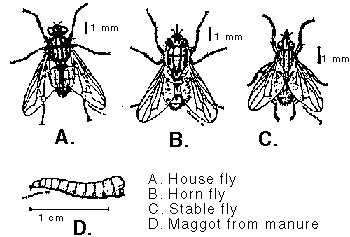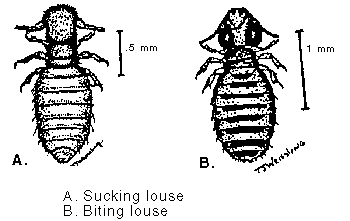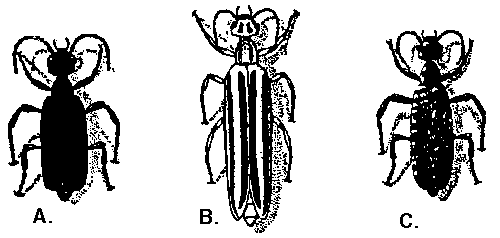
 |
||
Horse Arthropod Pests |
no. 1.202 | |
| by A. Swinker and F.B. Peairs 1 | ||
The important arthropod pests of horses in Colorado are flies, gnats, mosquitoes, bots, lice, ticks, mites and blister beetles. Arthropods that feed on blood generally affect horses directly or indirectly. Direct effects on the host are attributed to the pest's presence and physical nuisance.
Bothersome insects can cause the animal to become nervous and interrupt performance. Nuisance pests can cause the horse to stomp, rub and constantly switch its tail. The increased stress load can quickly compromise the health of an animal. Indirect effects are transmission of pathogens (disease-producing organisms).
Blister beetles do not attack horses, but they are toxic to horses and can contaminate alfalfa hay. Management of these insects is different from other home pests in that it requires modification of alfalfa production practices.
Face fly and house fly. These flies are nonbiting, annoying, small black flies. Face flies closely resemble the common house fly but are more persistent pests of animals. They feed on the tear ducts of the eyes, around the nose or on wounds and cuts. Both species breed in fresh animal manure.
Stable fly. This small, grayish-black stable fly has a painful bite. It pierces the skin and sucks blood as a food source. The stable fly lays its eggs in piles of decaying vegetation such as grass clippings, manure and urine, contaminated hay and wet feed.
House, face and stable flies can all transmit disease, infection and the parasite Habronema (stomach worms). Infected flies deposit stomach worm larvae in open wounds that result in a lesion similar in appearance to summer sores. These larvae remain in the wound without maturing and cause inflammation and infection. Habronemiasis can be controlled with ivermectin dewormer.
Horn fly. This very small fly (half the size of the house fly) sucks blood and is a nuisance to horses pastured with cattle. Horn flies feed while hanging downward on the sides and legs of cattle and horses. The larvae of this fly also develop in manure.
 |
| Figure 1: House, horn and stable flies. |
Horse fly and deer fly. The female horse fly and deer fly attack horses. Their bite is extremely painful and causes a flow of blood that attracts house flies. The horse fly is plentiful in Colorado and a real nuisance. Deer flies have yellowish-orange and black body markings, picture-type wings, and are smaller than horse flies. Horse flies carry equine infectious anemia. The flies lay their eggs in damp or wet soil near streams, irrigation ditches or lakes. Within one week, larvae hatch and emerge later in the season as the full grown adult fly.
Black fly. This tiny, humpbacked fly can congregate in tremendous numbers around horses, causing extreme annoyance and itching. They feed most commonly inside the ear but also are found on the head, neck, chest and abdomen. Their bite can cause hemorrhage and bloody crusts. Larvae develop in fast moving rivers and streams.
Gnat (biting midges or small flies). Two genera, Culicoides and Leptoconops are major pests to horses. They have a painful bite and may cause hypersensitivity or "sweet-itch" along the base of the mane and tail and over the withers, chest and facial areas. Lesions consist of self-inflicted hair loss and excoriations with crusting. Larvae develop in aquatic habitats and decaying vegetation and manure.
Mosquito. These insects feed on horses in great numbers and can produce significant blood losses and annoyance. Skin eruptions can appear on horses bitten by mosquitoes. Mosquitoes also transmit equine infectious anemia (EIA), eastern equine encephalitis (EEE), western equine encephalitis (WEE) and Venezuelan equine encephalitis (VEE). Vaccines are available for EEE, WEE and VEE. Mosquitoes reproduce in large numbers in standing water found in marshes, irrigated pastures, abandoned tires and old feed pans. Many species can fly several miles from their breeding sites to feed. (See fact sheet 5.526, Mosquito Management).
Bot fly. Three species of bots are considered serious pests of U.S. horses. The bot is the larval stage of the horse bot fly, Gastrophilus species. Bot fly species vary in where they lay their eggs on the horse and how the eggs hatch. In general, they lay eggs on the forelegs, shoulders and lips during the summer and fall. Where the eggs are laid describes the three species: common bot fly, chin bot fly and nose bot fly.
The eggs hatch when the horse licks and rubs them. Once in the mouth, the small bots burrow into the gums and tongue where they remain for about one month and then migrate into the stomach. Upon entering the stomach, the larvae attach themselves to the mucus membrane and remain there for the next eight to 10 months. They detach themselves in the spring and pass through the feces.
Once outside the host, the larvae pupate. Mature flies emerge in four to six weeks. The flies mate, the adult females lay eggs, and the cycle begins over again. The flies do not bite, but egg-laying is annoying to the horse. The principal damage caused by the bot is to the stomach lining. In extreme cases, bots can cause a stomach rupture or fatal colic if they block the stomach valve to the small intestine.
 |
| Figure 2: Lice. |
Lice. Lice are normally species-specific external parasites. The horse sucking louse, Haematopinus asini, feeds on blood. Lice are seen on the head, neck, mane and tail during winter and early spring. Adults and nymph stages can be seen moving through the hair; the egg or nit stage attaches to the hair. Lice produce several generations per year and can complete a life cycle in three weeks. The horse biting louse, Bovicola equi, also infests horses. They feed on the epidermal skin tissues and secretions. Poultry lice have occasionally infested horses. Infested horses rub, bite themselves, stomp and exhibit extreme annoyance and discomfort.
Tick. In the United States, horses serve as a primary host for two species of ticks and a secondary host for 14 other species. Heavy tick burdens can result in general unthriftiness, anemia and susceptibility to disease. Ticks carry diseases such as Lyme disease found in many Eastern states.
Mite. This very small parasite is fairly uncommon to horses. However, the two forms of mites that affect horses are sarcoptic mange mite (burrows into the epidermis) and the psoroptic mange mite (lives on the skin surface). Both feed on skin and tissue fluids. Symptoms are irritation, itching and scratching.
A combination of control methods works best to successfully manage insect pests. Management options are summarized in Table 1.
Removal and proper management of manure is a key to management of several horse pests, including face flies and horn flies. Stable flies and house flies breed in mixtures of manure, spilled feed and decaying bedding around the barn. To help eliminate fly breeding areas, spread the manure regularly and prevent accumulation of other wastes. Several pesticides can be used on manure piles to prevent maggot development.
Puddles, tires and irrigation ditches are common aquatic breeding sites for the mosquito. Develop drainage systems to prevent standing water in irrigated pastures and irrigation systems. Eliminate other areas where water accumulates. Move or drain containers that hold water for long periods of time. Clean rain gutters to permit the free flow of water. Slope corrals and paddocks to permit proper drainage. Control weeds along ditch banks for free water flow.
Vegetation management around horse facilities is important. Several fly species use shaded areas for resting sites during hot periods of the day. To help reduce fly problems, eliminate or mow weeds and other plants that might provide shaded resting sites. To control tick populations, eliminate brush through cutting or burning. Pasture rotation will help control certain species of ticks.
Stabling horses during daily peaks of fly activity can provide some relief. Screening stable windows and doors will reduce interior fly activity. If stabling is not feasible, individual protection devices such as ear nets, face masks and repellant tags or tapes can be considered. Owners should perform seasonal practices such as castration when the fly population is smallest (i.e., winter) and the wound has the least exposure to flies.
Biological control is the use of other organisms (pathogens, parasites, predators and competitors) to reduce populations of arthropod pests. These methods can take several months or years before any results can be seen.
Biological insecticides such as Bacillus thuringiensis var. israelensis, a bacteria, can be used to treat free-standing water for mature mosquitoes and to treat running water for mature black flies. It is available under several trade names. Mosquito fish or top-feeding minnows (Gambusia) are effective predators of mosquito larvae.
Several commercial enterprises offer other beneficial insects for control of livestock pests, particularly manure-breeding flies. These are quite effective under some conditions, but none have been tested rigorously for use in Colorado.
Pesticides can reduce pest populations or repel economically important species of arthropods. To make sure you choose the correct product, you must correctly identify the pest species. Before using a pesticide, read the label. Understand the directions for proper preparation and application of the insecticide for a specific pest. Follow all directions and precautions.
There are many insecticides registered for control of horse pests. Because registrations change rapidly, specific products are not mentioned in this fact sheet. Good sources of up-to-date insecticide registrations for horses include Colorado State University Cooperative Extension county offices, the Nebraska Cooperative Extension publication, Nebraska Management Guide for Control of Arthropod Pests of Livestock and Horses, and the Texas Agricultural Extension Service publication, Suggestions for managing external parasites of Texas livestock and poultry.
While you do not need to know the individual active ingredients of home pesticides, you should know the three major classes:
Insecticide resistance is becoming a very serious problem in livestock arthropods. Resistance tends to develop by class rather than by individual product. If resistance seems to develop, switch to a product in another class. Also, rotate from insecticide class to insecticide class to avoid the development of resistance.
Pesticide applications can be divided into area sprays, residual premise sprays and direct animal treatments. Apply pesticides directly to horses with sprays, sponges, roll-ons, slow-release plastic strips, pastes, gels and feed additives.
Area treatments. Mist blowers, as well as hydraulic sprayers, loggers and aircraft, can be used to apply fast-acting, short-lived insecticides for immediate relief. Fine droplets are dispensed into areas occupied by flies, killing them on contact. This method is very efficient in terms of time and labor but has no long-term effect on fly populations.
Premise treatments. Residual insecticides control flies for one to two weeks. Apply insecticides as a coarse spray under low pressure to shaded resting areas. House flies are most commonly found under eves and on walls, rafters and ceilings. Stable flies, on the other hand, commonly rest outdoors, on the shady side of buildings, windbreaks and other vegetation. Be careful not to contaminate feeders, water buckets or equipment. Remove horses from barns before spraying. With some sprays, horses must remain out of the barn for a short period.
Direct horse treatments. Apply mist sprays that require a fine mist with either a small mist blower or a hand-held mist sprayer. One of the easiest methods to spray a few horses for fly and mosquito control is with a small, compressed air sprayer. The apparatus is quiet and does not frighten the animals. If you have a horse that is frightened by sprays, wet a sponge, cloth or mitt and wipe the solution on. Not all animal insecticides are suitable for use on horses, so be sure that horses are specifically mentioned on the label.
| Table 1: Management recommendations. | |
| Pest | Recommendations |
|---|---|
| Face fly | Manure and vegetation management, stable screening, premise sprays, repellents, horse sprays. |
| House fly | Manure and vegetation management, stable screening, premise sprays, repellents, horse sprays. Stable or provide shade to horses during peak fly activity periods. |
| Stable fly | Manure management, screening of stables, vegetation management, area sprays, premise sprays, repellents, horse sprays. Stable or provide shade to horses during peak fly activity periods. |
| Black fly | Repellents, horse sprays. Stable or provide shade to horses during peak fly activity periods. Provide individual horses with ear nets or applications of petroleum jelly to the inside of the ears. |
| Deer & horse flies | Repellents, horse sprays. |
| Mosquitoes | Larval management by elimination of standing water and approved larvicides. Minnows (fish) where standing water cannot be drained or treated. Repellents. Encephalitis vaccines. |
| Bots | Consult your veterinarian for drugs available for internal parasite control. Remove (by clipping or scraping) the yellowish bot eggs from the horses hair before they hatch. Warm water will cause eggs to hatch, allowing small larvae to be killed before they enter the mouth. |
| Gnats | Repellents, horse sprays, fans placed in stalls. Apply corticosteroid creams to the allergic skin lesions. |
| Mites | Labeled pesticides are effective in controlling mites. Quarantine affected horses. |
| Lice | Animal sprays can easily control lice. Do not stable horses near poultry. Good grooming is also important. |
| Ticks | Pasture mowing and brush removal. Rotate to pastures with lower tick populations. Repellents and/or residual insecticides. |
Blister beetles get their name from the fact that they produce a chemical, cantharidin, that can raise blisters on human skin. Cantharidin, taken internally, also is toxic to a number of mammals, especially horses. Blister beetle poisoning has become a problem for horse owners in recent years because of a combination of blister beetle biology and alfalfa harvest practices.
Blister beetles are common in Colorado, with more than 100 species known to occur. The larval stages of our largest group, Epicauta, are unusual in that they feed on grasshopper eggs. Because of the larval feeding habit, blister beetles tend to occur in areas where grasshoppers are common. They are more numerous when grasshoppers are abundant. Adult blister beetles feed on flowers of several crops, including alfalfa. They tend to feed in groups or swarms.
Blister beetles are concentrated in alfalfa hay during harvest when swarms are trapped by harvest equipment and crushed by the conditioners and tractor tires before they can escape. While many believe that the presence of a single beetle in a bale of hay poses a health hazard to a horse, the risk is not quite that great. It varies with the type of blister beetle. Although cantharidin is extremely toxic to horses, blister beetles are small and individually do not contain a lethal dose.
Colorado State University measured the cantharidin levels in several blister beetle species and estimated their relative risk to horses of different body weights. Based on average cantharidin content, and assuming the presence of equal numbers of male and female beetles, the lethal dose of three species is shown in Table 2. Clearly, different blister beetles species pose different risks to horses. Take these differences into account in management decisions.
| Table 2: Number of blister beetles lethal to a horse weighing (lbs): | |||
| Species | 275 | 550 | 825 |
|---|---|---|---|
| Black blister beetle | 550 | 1,100 | 1,700 |
| Spotted blister beetle | 175 | 345 | 520 |
| Three-striped blister beetle | 40 | 90 | 120 |
 |
| Figure 3: Black blister beetle, Epicauta pennsylvanica; three-striped blister beetle, E. lemniscata; and spotted blister beetle, E. maculata. |
There are several components of blister beetle management: cultural practices, chemical control, and selection of alfalfa hay sources. See 5.524, Blister Beetle in Forage Crops.
Cultural practices involve timing of cutting and modification of harvest equipment. Because blister beetles are attracted to flowers, cut the crop before bloom to reduce their presence in hay. It also is important to control flowering weeds and choose harvest equipment that gives the beetles the best chance of survival. Research at Kansas State University has shown that self-propelled swathers, without conditioning rollers but with windrowing attachments, are safer than mower conditioners and sicklebar mowers. Even with the conditionerless swather, avoid hay from the ends of the fields where the machine is turned around and beetles may be crushed by the tires.
Chemical control treats the crop just prior to harvest to eliminate beetle activity during harvest. There is not much data on blister beetle control. Most recommendations seem to be based on preharvest intervals. Refer to 564A, High Plains Integrated Pest Management Guide, for future information on alfalfa insecticides.
Select hay sources that have a low likelihood of blister beetle contamination. First cutting hay is the least likely to have beetles. Hay from third and fourth cuttings is the most likely to have beetles. Hay from alfalfa fields located near rangeland also is relatively risky.
1A. Swinker, Colorado State University Cooperative Extension horse specialist and associate professor, animal sciences; and F.B. Peairs, Cooperative Extension entomologist and professor, bioagricultural sciences and pest management. 6/98.
Go to top of this page.